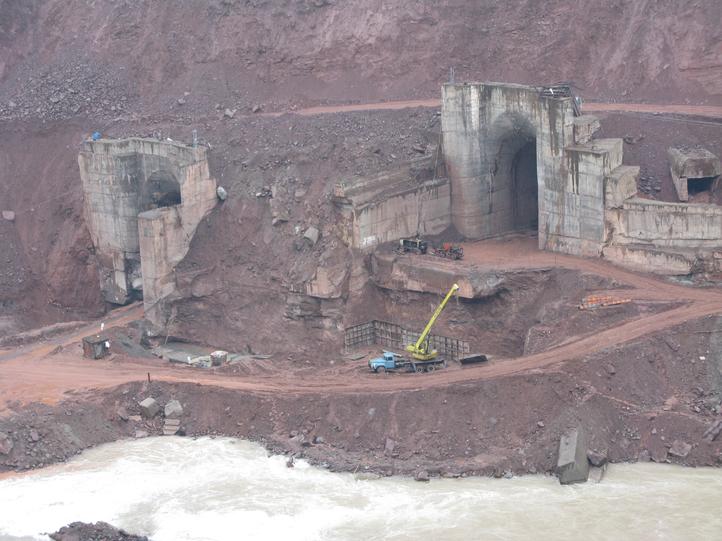
Rahmon Balances Domestic and Foreign Pressures Over Rogun Project
Publication: Eurasia Daily Monitor Volume: 8 Issue: 213
By:

On November 3, Tajik authorities announced that they had completed the main diversion tunnel of the Rogun Dam project. This means that it is now technically possible to divert the Vakhsh River from the part of the valley in which they plan to place the giant dam. Dewatering the construction areas will allow the authorities to start building the facility (www.avesta.tj, November 3).
According to Tajik hydropower experts, there are strong technical reasons for blocking the river as soon as possible. The lake created behind the temporary dam when the river is diverted will enable the authorities to accumulate water next spring and summer. This water can be released in winter so that downstream hydropower plants (HPPs) convert it into additional electricity, helping the country to prevent blackouts (www.avesta.tj, November 3). Besides, the lake will stop the sedimentation of the Norak HPP’s reservoir further downstream, which is reportedly close to reaching a critical level (www.regnum.ru, November 7). Any serious breakdown of the Norak facility, which produces about 70 percent of the country’s electricity output, will have catastrophic consequences for the country. Overall, according to the company building the dam, “the diversion of the river is technically possible now,” but, “the decision to block the river flow is essentially political and has to come from the highest level” (www.avesta.tj, November 3), that is, from the country’s president.
In deciding when and whether to start diverting the Vakhsh River, President Emomali Rahmon will have to find a proper balance between domestic and foreign pressures. Within Tajikistan, there is not only overwhelming support for the construction of the Rogun Dam, but strong public pressure to start the construction as soon as possible. Most Tajiks view the dam as a way out of the energy shortages that have plagued the country for most of the past decade. The country’s aging hydropower plants generate enough electricity in warmer seasons to meet domestic needs. In winter, however, energy demands peak while water levels in rivers fall, leading to energy deficits – currently standing at about 2 billion kWh per year (www.khovar.tj, October 12). As a result, authorities resort to rolling blackouts from the late fall to early spring, leaving most of the country with only two to four hours of electricity per day.
Power outages are expected to be particularly pronounced this year. Scarce precipitations last winter and an unusually dry and cold spring kept reservoirs behind Tajikistan’s major hydropower dams half empty for most of the year. As a result, the authorities began rationing electricity supply to the population this year one month earlier than in recent years (www.khovar.tj, October 14).
Confronted by growing public anger over the chronic energy shortages, President Rahmon has made the development of Tajikistan’s energy sector the main focus of his government. The 3,600 megawatt Rogun Dam project, which was designed by Soviet engineers in the 1970s, has been elevated to the status of a “national” project in Tajikistan. Unable to secure external investment for the 335 meter dam, which is estimated to cost up to $3.6 billion, the Tajik government has financed the initial phases of the project from state budget funds. The country spent $420 million in 2009-2011, and is planning to spend another $223 million on the project next year (Nezavisimaya Gazeta, November 3).
The major opposition to the project has come from Tajikistan’s downstream neighbor, Uzbekistan. Tashkent fears that the reservoir behind the Rogun Dam will require increased water withdrawals from the Vakhsh River, thus affecting the flow of water that Uzbekistan needs to irrigate its cotton fields. The Uzbek authorities have also claimed that the giant power station will have adverse environmental impacts. Ironically, Uzbekistan’s fierce opposition to the Rogun project has helped to turn it into a symbol of national pride for most Tajiks, who now see Tashkent’s objections as an additional motivation for the completion of the dam (www.cacianalyst.org, June 22).
In an attempt to overcome Tashkent’s opposition and persuade international financial institutions to fund the Rogun projects, Dushanbe requested the World Bank to conduct two independent studies assessing the dam’s economic feasibility and its potential social and environmental impact. The results of these studies will be available in the summer of 2012. Pending these results, the World Bank has requested that the Tajik government suspend the construction of the dam and the resettlement of people from the dam’s projected flooding zone (www.cacianalyst.org, June 22, August 31). A similar message was recently delivered by the US Secretary of State Hillary Clinton. On October 22, speaking at a meeting in Dushanbe, Clinton insisted that Tajikistan should not build the dam before the findings of the World Bank-commissioned studies become available. She also announced that if these studies advise against the project, Tajikistan should look for alternative ways of producing electricity (https://www.state.gov/secretary/rm/2011/10/175985.htm).
The diversion of the Vakhsh River at this point would draw international condemnation of the Tajik government. Therefore, it is likely that President Rahmon will decide to postpone the diversion until after the results of the feasibility studies become available. It is highly improbable, however, that any findings from these studies can persuade Tajikistan to abandon the cherished project.




